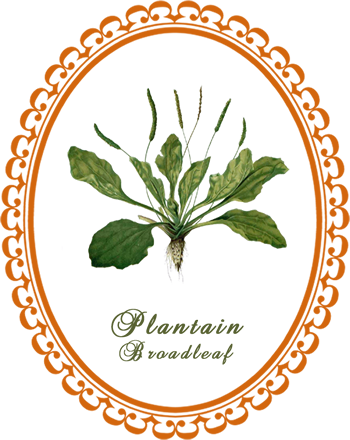
Greater Plantain: these commonplace weeds were prized in years gone by - and still valued by many - for their tasty and nutritious foliage, richer than spinach in iron and Vitamins A and C ...
Common Names: Greater Plantain, Broadleaved Plantain, White Man's Foot
Botanical Name: Plantago major
Family: Plantaginaceae
Plant Type: Perennial
Parts Used: The whole plant
Flowering: April to October
Native to Europe, broad-leaved plantain grew so rapidly and abundantly in America, the Native Americans called it "white man's foot", because it was said that this herb grew wherever the white man stepped. Plantain inhabits fields, meadows, lawns, sidewalks, roadsides, and waste places. A New leafy whorl appears a day or two after the plant is cut to the ground.
Description: The leaves all radiate from the base, but in some species the leaves are broader than others. They are dark green in color and strongly ribbed lengthwise. The flower stem is stiff and smooth and reaches heights of 6 - 18 inches. The head is short and studded with tiny four-parted dull white flowers with long slender stamens.
Culinary Uses: Plantain leaves can be eaten as a bitter green when young, either in salads or as a cooked green.
Plantain Magick
Healing. Strength. Protection. Snake Repelling.
Gender: Female
Planet: Venus
Element: Earth
Place plantain beneath your feet to remove weariness.
Bind the plantain with red wool to the head to cure headaches.
Carry a piece of the root in a pocket to protect from snakebites.
Hang plantain in the car to guard against the intrusion of evil spirits.
Herbal Healing with Plantain
Medicinal Actions: Alterative, antibacterial, anti-inflammatory, antiseptic, astringent, diuretic
Medicinal Uses: Greater Plantain has been used as an alternative medication for asthma, emphysema, bronchitis and other respiratory problems due to its abilities as an expectorant. It is also used for bladder problems, fever, hypertension, rheumatism and to regulate blood sugar. A decoction of plantain can be used for diarrhea, dysentery, gastritis, irritable bowel syndrome, peptic ulcers, hemorrhage, hemorrhoids, sinusitis and hay fever. The green seeds and stem boiled in milk will generally check diarrhea and bowel complaints of children. The clarified juice, seeds or both, made into a tea or jellylike water and taken by itself or mixed with other herbs, relieves intestinal pain of ulcers, excessive menstrual flow, and inflammation of the intestines.
It causes a natural aversion to tobacco. Plantain can be used to relieve colitis and incontinence. It is a mild diuretic. It may slow tuberculin and staphylococcus infections. It removes obstructions in the liver and helps jaundice as well as aiding detoxification of the body. It is showing promise as a controlling herb for cholesterol and as a laxative.
Externally, Greater Plantain leaves can help wounds stop bleeding when applied directly to the surface. The leaves can also be heated and applied to inflammation of the skin, ulcers, cuts, stings and swellings. A poultice of leaves that have been heated will draw out thorns, splinters and infection. The root has been used for snake bites. Take 1 tablespoonful of the juice of the leaves every hour, at the same time applying the bruised leaves to the wounds. A strong tea made from plantain can also be used as an eye wash for irritated eyes. For hemorrhoids, make a strong tea and let it steep 30 minutes; inject a tablespoonful or more several times a day and after bowel evacuation. As a feminine wash, use 2 tablespoonfuls of plantain to 2 cups of water, simmer covered, cool, strain. Add enough water to fill a container. The leaves dipped in cider vinegar and dried overnight, then placed on the feet before putting stockings on, will aid leg pains. An ointment can be made by slowly boiling for 2 hours 2 ounces of granulated plantain in 2 cups of soy bean, coconut, peanut, or other soluble oil. Greater plantain can be added to comfrey (Symphytum), chickweed (Stellaria) and calendula (Calendula) to make an all-purpose salve.
Contraindications:
There are no known contraindications for greater plantain's use. It does not interact with any known drugs or herbs.
Body Care with Greater Plantain
Infusion: An herbal tea can be made from 1 tablespoon of dry or fresh plantain (roots, leaves and seed) in 1 cup of boiling water. Steep tea for 10 minutes and strain. Sweeten if you wish with honey. Drink as needed during the day.
Plantain Salve: Add 1 pound of chopped plant into a jar of olive oil. Remove all air bubbles and cap. Let the herb steep for six weeks in a dark place, shaking daily. Strain out herbs and add the oil to a small amount of melted beeswax to create the desired consistency. Pour into small jars. When cool, use for burns, diaper rash, insect bites, cuts, rashes and any other skin irritation.
If you appreciate the information provided,
please help keep this website running. Blessings!
© 2008-2022 aromaworx.ca. All rights reserved.

